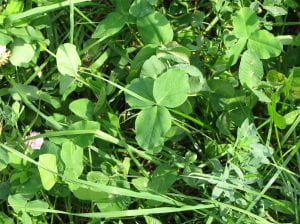
March is usually a great time to add some legumes by frost seeding into your pastures, hayfields, or winter small grains. It is a way to improve grasses without losing a production year. It is also an excellent way to add legumes back if you used a broadleaf weed control last growing season. Added legumes will boost production and fill in thin patches or bare spots; they will provide needed nitrogen to the warm or cool season grasses already growing and improve plant protein content. Little or no tillage is involved which reduces the potential for soil erosion.
For frost seeding to be successful seed-to-soil contact is critical. What works with this technique is the freeze-thaw process in late winter/early spring. This action tends to work better on heavier soils as they are more likely to crack or form the ‘honeycombs’. We have had ample precipitation this winter so I have seen the honeycombs on frozen mornings. As the days get above freezing and nights below freezing, this action works the seeds down into the soil in preparation for germination. Spreading seed on frozen ground reduces the potential to rut up the pasture or field. This can be done best early morning or possibly late in the day.
Legumes work best for frost seeding due to the shape of their seeds and will germinate under cool conditions. Success will vary farm to farm, but clovers will establish better, specifically red clovers. They are more tolerant of low pH and low fertility but are shorter-lived in pastures. A way to overcome that would be to routinely frost seed half your pastures every year, alternating fields. It can be an inexpensive improvement.
Suggested rates are below. The price of seed is relatively low, so don’t skimp. Make sure you use inoculated seed or purchase the correct inoculum.
Lbs/Ac
Red Clover – 6 to 10
Ladino Clover – 2 to 4
Birdsfoot Trefoil – 5 to 8
Equipment for frost seeding can be as small or as big as needed. The size of the pasture or field will dictate what is needed, unless you have time and the desire to walk a large field with a small cyclone spreader. A broadcaster can be mounted on the back of an ATV or small tractor.
If a soil test report shows phosphorous or potassium is needed wait until late summer. Fertilization will help seedlings get established and ready for next winter.

